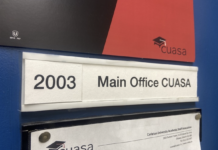The rhythmic sounds of drums and song filled the Ravens’ Nest March 31 and April 1 as members of Ottawa’s aboriginal community gathered at Carleton for the 15th annual Aboriginal Family Festival.
The two-day event honoured aboriginal youth and featured dance demonstrations, a baby welcoming ceremony, a “tiny tot” special, and aboriginal arts and crafts.
Non-aboriginal attendees were invited to join in inter-community dances, learn the steps and experience the culture firsthand.
Irvin Hill, Carleton’s aboriginal liaison officer, said the cultural festival is geared towards bridging gaps between communities.
“It’s about bringing people who haven’t seen this before, who really don’t know anything about aboriginal culture or people,” Hill said. “It brings things to the modern day. So it’s bridging that gap between aboriginal and non-aboriginal, and from the past to the present as well.”
Ottawa Centre Liberal MPP Yasir Naqvi spoke highly of the event in an address to the Ontario legislature.
“The festival is truly youth focused and young people are encouraged to be involved not only in the dancing and drumming but to be involved and active in the aboriginal culture and tradition,” he said.
A group of local aboriginal organizations started the annual event to find a way to honour and pass on their cultural knowledge to the youth of their communities. The first powwow took place at the Odawa Native Friendship Centre. The festival eventually outgrew the small gym and with the help of Carleton’s Centre for Aboriginal Culture and Education (CACE), it moved to the Ravens’ Nest in 2010.
Students, as well as community members, said they were very pleased with the move.
Carleton graduate student Naomi Recollet said she has been dancing since she started walking.
She said these powwow events help her feel at home, despite being far away from her native Manitoulin Island.
“Being away from home, [the Aboriginal Family Festival] allows me the chance to connect with other First Nations people and share and laugh like a real community would do,” she said.
“For me, as a student, it has a sense of comfort and a sense of being home.”
Recollet is one of an estimated 500 to 700 aboriginal students at Carleton. Hill said the CACE is in touch with roughly 200 of those students.
Many aboriginal people choose not to self-identify for a variety of reasons but the centre aims to make all aboriginal students feel welcome, Hill said.
In addition to the CACE, aboriginal students can also seek help from the First People’s Council, Aboriginal Student Services, and a new Inuit student club.
Over the past seven years she’s been at Carleton, Recollet said she’s seen the university develop new resources for the aboriginal community.
Events like the powwow festival, she said, are another example of how the university is becoming attuned to the needs of its aboriginal students.






